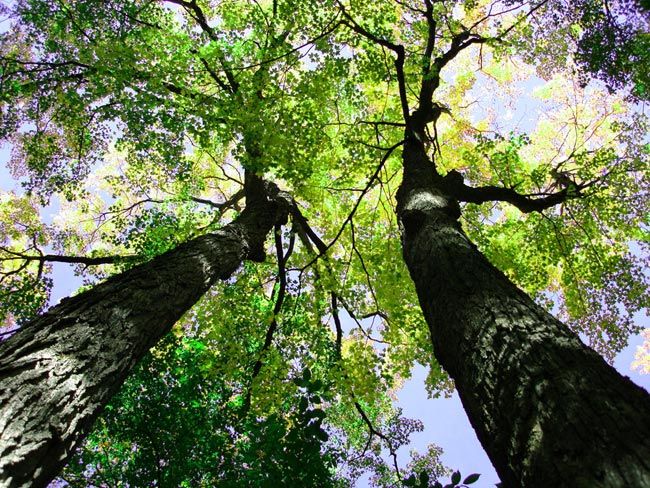Study: Tree Leaves Have Built-In Thermostat

Whether in Canada or the Caribbean, tree leaves don't have to worry about the temperature outside — they have their own built-in climate control that always aims to keep them comfortable, a new study finds. The long-standing view of plant biologists was that the temperature of a photosynthesizing leaf would be the same as that of the surrounding air. But in a survey of 39 tree species ranging over 50 degrees of latitude across North America (between Puerto Rico and Canada), biologists at the University of Pennsylvania found that tree leaves stay at a nearly constant temperature while they're converting sunlight and carbon dioxide into food. The study, detailed in the June 12 issue of the journal Nature, finds that tree photosynthesis most likely occurs when a leaf's temperature is about 69.8 degrees Fahrenheit (21.4 degrees Celsius), with the latitude and average growing-season of the plant's environment playing little, if any, role in its temperature. Instead, the leaves likely have physiological and structural adaptations that help them stabilize their internal systems (we humans do this when we sweat or shiver in response to hot and cold temperatures to maintain our body temperature). This discovery comes as something of a surprise to biologists. "It is not surprising to think that a polar bear in northern Canada and a black bear in Florida have the same internal body temperature. They are endothermic [warm-blooded] mammals like us and they generate their own heat," said study team member Brent Helliker of Penn. "However, to think that a black spruce in Canada and a Caribbean Pine in Puerto Rico have the same average leaf temperature is quite astonishing, particularly since trees are most definitely not endothermic." Helliker and his colleagues think that increasing evaporation and leaf angle (which affects how much sunlight it reflects) help cool leaves in warm climes, while decreasing evaporation and the clustering of many leaves on each branch help keep leaves warm in colder places. The results of the study, funded by the Department of Biology at the University of Pennsylvania and the Andrew W. Mellon Foundation, have implications for how trees in northern climates will react to global warming: They might overheat due to mechanisms they have evolved to "keep warm." The results also have implications for scientists studying past climate change by measuring the ratios of different isotopes of oxygen (which have different numbers of neutrons) in tree-ring cellulose. The amount of a particular isotope present in the cellulose is influenced by the temperature of the leaves, and scientists had assumed that leaf temperature was the same as the ambient temperature. The new study has shown this isn't the case.
- Video: Fungus Threatens Christmas Trees
- Top 10 Surprising Results of Global Warming
- Top 10 Poisonous Plants
Sign up for the Live Science daily newsletter now
Get the world’s most fascinating discoveries delivered straight to your inbox.

Andrea Thompson is an associate editor at Scientific American, where she covers sustainability, energy and the environment. Prior to that, she was a senior writer covering climate science at Climate Central and a reporter and editor at Live Science, where she primarily covered Earth science and the environment. She holds a graduate degree in science health and environmental reporting from New York University, as well as a bachelor of science and and masters of science in atmospheric chemistry from the Georgia Institute of Technology.











